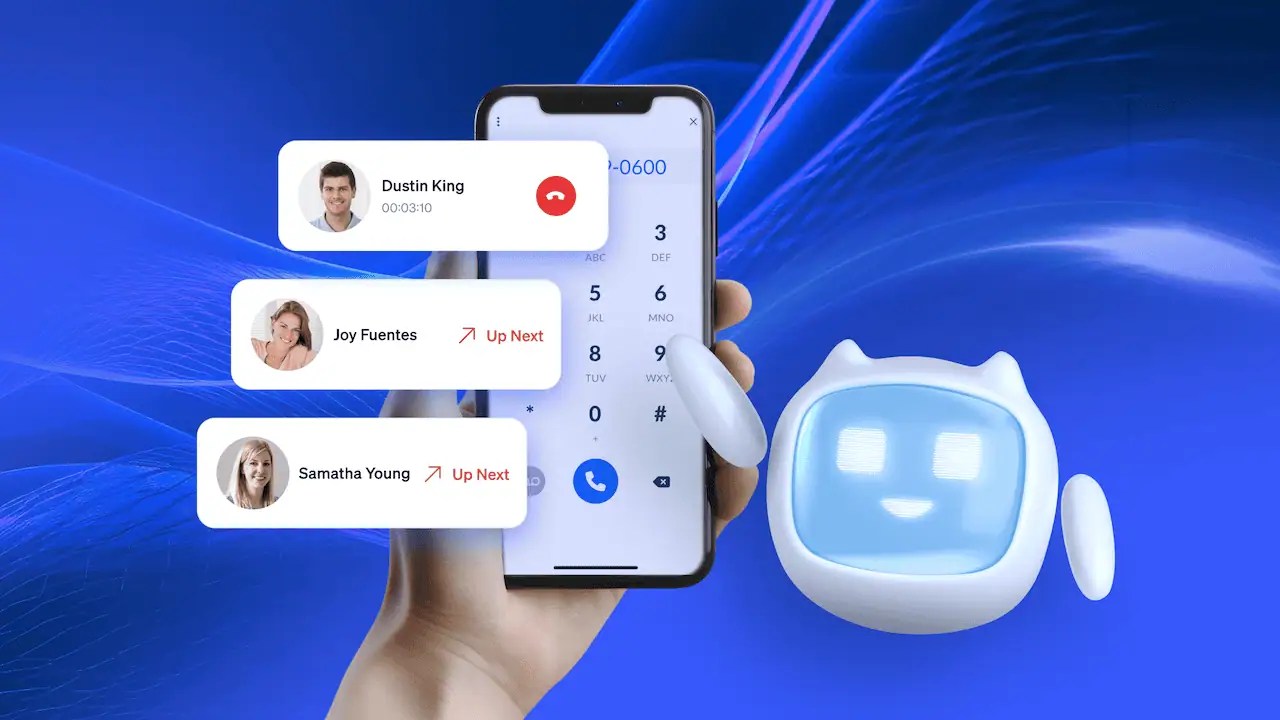When there’s system downtime or dead time in your business, it can feel like a free pass to sit and put your feet up.
But if you’re the owner of that business or responsible for increasing performance and efficiency, it’s a serious concern. The business isn’t growing, and you aren’t providing the experience your customers expect.
That’s a big problem.
Call centers are no strangers to this issue. Even the slightest decline in performance (such as increased average handle time or high call abandonment rate) has knock-on effects. These problems lower customer satisfaction and create all sorts of issues around resource planning and call center operations.
We call this phenomenon call center shrinkage. It’s a problem no call center manager wants to see come across their desk.
What Is Call Center Shrinkage?
Call center shrinkage refers to the time agents are unavailable to handle calls due to planned or unplanned activities.

On paper, all call center agents would always be available — logged in and ready to take the next call. In reality, a good call center shrinkage rate is around 50% or lower.
That’s right. Working in a call center could mean that half an agent’s time isn’t spent handling incoming calls.
That’s not to say the agents are at fault — far from it. But you must keep an eye on your call center shrinkage so that “I was busy with other tasks” doesn’t become the norm. There are many other activities we often miss when planning our number of agents versus the volume of calls.
And there are other losses, too. Outside of agent idle time, the following factors could contribute to your call center shrinkage:
- Disjointed workflows
- System maintenance
- Repeated calls (on the same issue)
- Poor documentation
- Compliance violations
Before we attempt to improve our shrinkage figure, we must learn exactly what’s causing it.
Causes of Shrinkage
There are many potential causes of call center shrinkage. They fall into three categories. See if you can spot which one is the main concern for the downtime in your business.
Scheduled activities
It’s important to recognize that agents can’t be tied to their desks all day. You should also consider the types of activities that will contribute to their growth and performance.
Scheduled activities that have a bearing on call center shrinkage include:
- Breaks: Unavoidable, and many agents need longer breaks.
- Training sessions: Unavoidable, and many agents need more training.
- Meetings: Avoidable if your internal communications planning improves.
- Administrative tasks: Avoidable with the right software and better workflows.

“With better agent training, you can boost morale and productivity, build resilience, and reduce your overall attrition rate by giving agents everything they need to nail every single call and feel good about the job they’re doing.”
Lucy McCormick
Unscheduled activities
There are external shrinkage factors that can further impact call center performance. These are inevitable events such as agents not coming to work. Obviously, if you suffer staff absences, there is a gap in your service level targets.
Unscheduled activities that have a bearing on call center shrinkage include:
- Sick leave: Enabling remote work often means lower sick rates.
- Personal time: Time out due to bereavement or childcare is unavoidable.
- Lateness: Working from home can minimize this, as can help with travel planning.
- Early departures: These are unavoidable if you appreciate that agents must balance their work and life.
Inefficient scheduling
Often the biggest contributor to downtime, poor agent resource planning can also have the most significant impact on call center shrinkage. This comes down to one major factor: mismatched agent availability versus call volume.
There are many factors that contribute to inefficient scheduling:
- Lack of workforce management software: Automate rotas based on real-world data.
- Lack of cross-skilling: More agents become available to deal with different queries.
- Lack of intelligent call routing: Tenured agents can take more advanced calls instead of ones needing basic support.
- Poorly configured IVR options: Reduce the likelihood of customers reaching the wrong agents.

Tracking Call Center Shrinkage
Before you try to remedy call center shrinkage, it’s important to understand exactly where you’re losing time.
Start by monitoring major key performance indicators (KPIs) and call center metrics.
Track key metrics
When thinking about shrinkage, focus on these four metrics:
- Scheduled time: How long agents have planned “available” time.
- Schedule adherence: Percentage of time agents are available to handle calls.
- Occupancy rate: Percentage of logged-in time that agents spend actively handling calls versus being available but idle.
- Agent idle time: The amount of time in an “available” state but not handling calls (such as after-call work).

Work out your shrinkage calculation
If you’re struggling with call center shrinkage, there’s a shrinkage formula you can use:
(Total unavailable time / Total scheduled time) x 100%
Take your number of hours unavailable and divide this by the total scheduled time.
When you have this number, multiply it by 100% to calculate your shrinkage percentage.
For example, if your total unavailable time is 40 hours and your total scheduled time is 200 hours, your shrinkage figure is 20%.
This would represent a good shrinkage number compared to the call center industry benchmark of between 30% and 35%.
3 Ways to Reduce Shrinkage
Now that you know exactly what’s causing your shrinkage and how your figure lines up with industry standards, we can focus on reduction.
1. Efficient scheduling and forecasting
If you’re using manual spreadsheets and Erlang calculators to create your staff rotas, you could see an immediate improvement by using historical data to predict call volume patterns.
This data will not only enable you to plan for the right number of agents at given times of the day, week, or month, but it will also allow you to react to unplanned events and periods of extreme call volumes.

Within this new forecast, you can schedule breaks and meetings during low-call periods. This can be either proactive, such as when there is a rare moment when no calls happen, or reactive, such as when the data suggests a common quiet time.
To optimize scheduling, consider WFM software to help automate data collection and resource planning. With this type of technology, you get demand forecasting, automated scheduling, and real-time monitoring. All these contribute to a more streamlined agent rota with fewer gaps for shrinkage.
2. Cross-training and skill development
If you have a larger pool of cross-skilled agents, you can assign them to other areas where you have resource gaps. Prioritizing and investing in agent training and development pays off in many ways here.
By empowering agents to handle a wider range of inquiries, you can assign agents to cover high-volume queries.This also has the benefit of mitigating the impact of unplanned absences.
Let’s say Gary in billing has an unexpected sick day. When Marissa, an agent covering inbound calls for customer support, can also handle billing queries, you can assign her that skill in a call queue, relieving the pressure on other agents and shortening queue times.

3. Optimization of breaks and lunch schedules
While flexible agent schedules offer many benefits, it’s important to keep them aligned with business needs.
By staggering breaks to facilitate adequate staffing during peak hours, you ensure that you have the minimum number of agents available at all times.
If you currently allow lunch breaks at 12 pm – 1 pm and 1 pm – 2 pm but suffer from staff shortages and high call volumes during this period, consider introducing 11:30 am – 12:30 pm and 1:30—2:30 pm breaks as well.
As former provisioning coordinators, both Rob Smith and I, used to take the 2 pm – 3 pm lunch break. This wasn’t just to balance the number of agents versus incoming calls but also a preference, as we enjoyed the shorter run in to the end of the day.

Balancing Shrinkage With Burnout
Agent burnout is often the cause of shrinkage. A lack of focus on employee engagement and well-being has repercussions on their service level and your business.
When planning your new rotas and breaks, consider the following criteria to help you manage your contact center agents.
Offer flexible work arrangements
Be it remote work or flexible shift patterns, you can attract and keep talent by catering to work-life balance preferences. You also avoid the potential of absenteeism and burnout.
When agents have small children at home, this divides the time and attention they need to give their family from the time and attention they give to customers.
Likewise, if certain staff are more productive during the morning, it makes sense to use their skills during that time. Forcing them to work later shifts is detrimental to both their productivity and your call center efficiency.
Improve communication and feedback
In some call centers, it’s difficult or embarrassing for agents to speak about how they’re feeling. In these cases, a major culture change is needed to address internal shrinkage or poor agent performance.
Start by creating an open channel of communication, either one-on-one or online. The simple notion of knowing a confidential and non-judgmental conversation can happen encourages agents to get things off their chests.
When supervisors understand the cause of idle time, sick time, or any other problem, they can work on it with the agent.
In addition to practicing active listening, providing regular feedback, coaching, incentives to boost morale and performance, and negative feedback when things go wrong can help improve communication.
Minimizing Shrinkage With Nextiva
Many factors cause contact center shrinkage and can only be remedied once you find the specific contributing factors in your business.
Using the formula (Total unavailable time / Total scheduled time) x 100%, you can compare your business against industry benchmarks and work on reducing your average call center shrinkage.
A comprehensive call center solution, such as Nextiva, can help you monitor and address your shrinkage proactively.
With built-in WFM, automated forecasting, and a host of reports, Nextiva puts you in control of your own destiny.
Ready to tackle contact center shrinkage? Take Nextiva for a spin here. 👇
The call center that does it all
Customers want personalized phone support. Your sales
and support teams want a flexible inbound call center.
It’s a win-win with Nextiva.

















 Customer Experience
Customer Experience 






